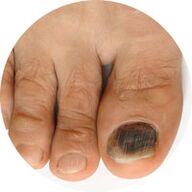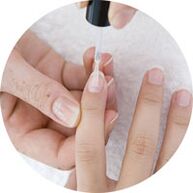The treatment of advanced forms of nail fungus takes more than a year. However, at an early stage, the disease can be fought faster. To do this, varnishes are created from the fungus on the nails on the hands and feet.
Varnish treatment of nails affected by fungus: tips and approach

Antifungal varnish is a tool that has recently become relevant in the fight against nail fungus in the early stages of infection, ie when less than 50% of the plaque is damaged.
The tool is convenient and practical: unlike ointments, it does not wipe off and does not wash off after drying.
However, antifungal nail polish is indicated in only 2 cases:
- In the early stages of the disease, when up to 30% of the plate is affected and no more than 3 nails on one foot, arm. Antimycotic tablets with wider and deeper foci should not be abandoned.
- To prevent onychomycosis. The coating reliably protects the nails from re-infection.
The drug can be prescribed for self-medication or as part of a complex treatment.
How does antifungal varnish work?
Varnish for the treatment of nail fungus on the legs and hands has a liquid structure, absorbs quickly and penetrates even micro cracks. The active substance begins to destroy the cell membrane, enzymes and spores of the pathogen. After hardening, the coating closes the plate, preventing oxygen leakage. Fungi that have no basis in vital activity stop multiplying and gradually die.
Mycologists prescribe a means to prevent fungus in humans, especially after excessive sweating and acrylic extensions. The resulting protective film prevents moisture, fungi and infections from entering the nail. In addition, alcohol, oils and plant extracts are disinfected and dried.
Effectiveness of treatment
Nail fungus varnishes are effective in the prevention and treatment of onychomycosis only in the initial stage. The drug forms a protective coating, quickly eliminates the infection and prevents a new appearance. Full recovery occurs after 3 months of therapy, the first results are noticeable after 7-10 days.
Tests should be performed a few weeks after the end of treatment. A laboratory test will show that the infection is completely gone and that a second course is needed.
Consult a mycologist or dermatologist before buying the product. The specialist will assess the extent and depth of the lesion, determine the stage and prescribe a suitable varnish for toenails or fingernails.
How to apply nail polish in the treatment of nail fungus?
The frequency of use of a particular tool is indicated in the instructions. As a rule, in the first month the nails are varnished once in 2 days, in the second - twice a week, in the third - once a week. Therapy is carried out until a healthy plate grows.

Nail fungus varnish on the legs and hands is applied according to the following scheme:
- Primary processing. Before treatment, feet or hands are steamed in a soda-salt bath and washed thoroughly with soap and water. Then wipe the surfaces dry and do a hygienic pedicure or manicure. The nails are cut, the top layer is polished with a nail file and wiped with alcohol.
- Application of funds. Fungal nail polish is applied to dry tiles with a brush or spatula. The movements are performed slowly and carefully so as not to damage the surrounding skin. In this case, the composition should cover the entire area of the nail.
- Post-processing. The applied drug should not be removed until the next procedure. However, after 10 minutes, after it is completely dry, a decorative varnish can be applied to the treatment varnish. The instructions indicate whether the manufacturer allows this option.
Contraindications
Therapeutic nail polish from fungus does not absorb into the blood and can not cause intoxication. However, the drug is contraindicated in the following cases:
- individual intolerance to components;
- prone to allergic reactions;
- increased skin sensitivity;
- Children under 16 years of age;
- pregnancy and lactation.
Varnishes are prescribed with caution in diabetes mellitus, diseases of the immune system.
Side effects
Varnish for the treatment of toenail fungus and hands rarely causes adverse reactions. In case of accidental contact with skin, it may manifest itself:
- combustion;
- redness;
- peeling;
- swelling;
- irritation;
- itching.
If an allergic reaction occurs, it is worth choosing an analogue with another active ingredient.
Attention! Nail fungus reduces the effectiveness of combined contraceptives.
Prevention

After complete recovery, the patient often becomes infected with the fungus again. To prevent recurrence, nails should be varnished for a month after the end of treatment.
Hygiene should be paid: wash feet and hands every day, change socks, dry shoes. Towels and slippers must be individual.
Remember: even the best nail fungus varnish requires regular application. The coating is gradually washed off without re-treatment. As a result, the soil will be suitable for the growth of fungi.
In conclusion, it should be noted that in the case of symptoms of nail damage with a fungal infection, and especially if it is accompanied by these favorable factors, it is necessary to seek professional medical help.
The practice of self-selection of therapies will not only not help in any way, but will also aggravate the current situation. It is very easy to get a gift in the form of a fungus on the nails, but it is very difficult to treat. Therapy takes a long time and is often complicated, so you should not start the course of the disease with self-medication.





























